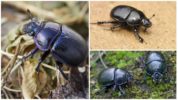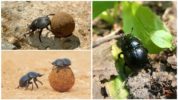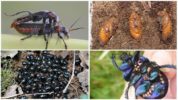- Dung beetle
- Dung Beetle Food
- Dung beetle breeding
Dung beetle is a hardworking, extremely useful insect. In the process of its life, loosens the soil, fertilizes, clears from carrion. Refers to the order of beetles, a subfamily of excavators. Builds burrows underground, lays eggs in the same place, grows larvae. The life cycle of an adult is 2 months.
Other names, mythical notes
In ancient Egypt, the divine being is Scarab beetle. His image is present on the walls of tombs, jewelry made of gold, silver, stones. With a scarab beetle, they make talismans that give confidence to their master, courage, strength, courage, wisdom. They are a source of health, family well-being, and hard work.
Interesting!
The erection of the "holy" beetle owes its vital activity. At night, he rolls balls from manure, just as the sun revolves around the earth. In this, the ancient Egyptians saw a mystical connection, began to revere the sacred beetle. Legends are made of him, insects are present in historical films about tombs. However, many do not realize that the dung beetle and scarab are one and the same.
In total there are about 600 species of dung beetles, 20 of them live on the territory of Russia. Other names are driller, digger, cleaner.
What does it look like
The dung beetle has a powerful body, a strong shell, a long straight mustache, 6 legs. Size ranges from 3 to 7 mm. The weight of an adult is 3 g. The shell is hard, convex, shimmers with a metallic luster. Color can be different - black, brown, beige.
On the head of the dung beetle, there are long straight mustaches with a brush on the tips. This is the main organ of smell, which helps the insect find food. The paws are short but powerful.
On a note!
The strength of the excavation is such that it is free to move food that exceeds it in weight tens of times.
Larvae are similar in appearance to adults, but white. Over time, the carapace darkens, hardens, acquires a characteristic color. A photo of the dung beetle is presented below.
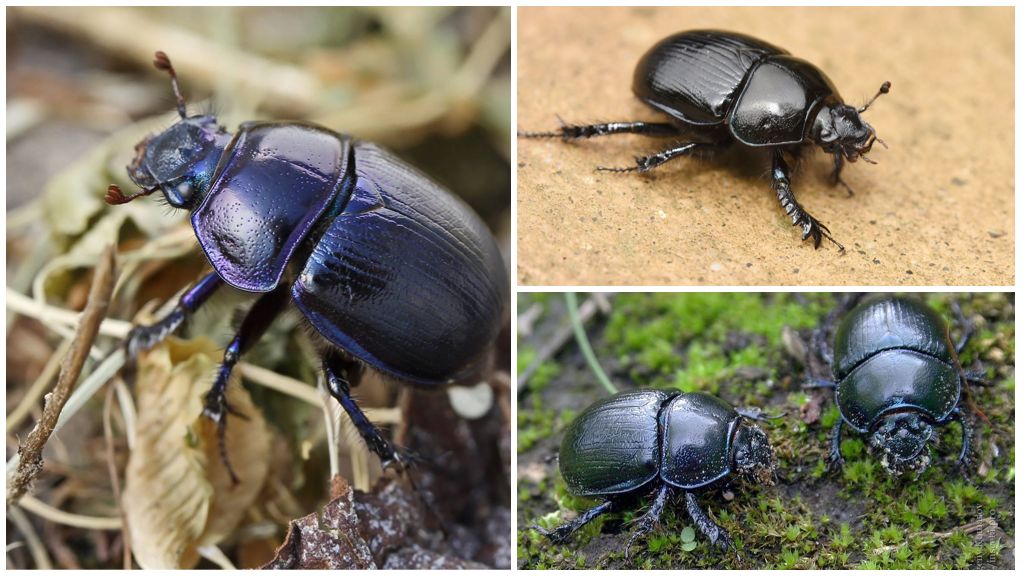
Types of dung beetles
Representatives of a huge family are found all over the world, but prefer countries with a temperate climate. Specialists distinguish several subfamilies that differ in size and appearance.
- Bolboceratidae. Large, medium beetles up to 3 mm. Color black, brown or two-tone, with a metallic sheen.
- Geotrupinae. Medium size. Appearance feature is the protruding lip, the upper jaw. The color is monophonic - black, brown.
- Lethrinae. Oval in size up to 4 mm. They live in holes, wings have lost flying ability. The carapace is black, with shine. A distinctive feature of the appearance are well-developed mandibles.
Common types:
- Anoplotrupesstercorosus. Lives in the forest, body size up to 2 mm. It is active from May to September. The shell is black, shiny.
- Onthophagusgazella. A brown scarab beetle. Head darker than abdomen. Homeland is Africa, distributed around the world.
- Trypocoprisvernalis. Oval body up to 2 mm long. Spring dung beetle is a rare species. It has a bright color with shine - black-blue, dark green. It prefers the edges of broad-leaved forests where cattle are grazed.
- Extemporaneousness. Green dung beetle with iridescent shell. The body is oval, reaches a length of 3 mm.Lives in meadows, fields, gardens.
- Anthropomorphous. The kaloyed bull is outwardly somewhat different from other species. The body is matte black, a mustache twisted on the head, like the horns of a bull. The head is hidden under the shell. Body size about 3 mm.
On a note!
Despite the great diversity of species, the beetles' life is identical. They bring a lot of benefits to nature, to humanity.
What eats, lifestyle
Diet of dung beetle - excrement, carrion, mushrooms. They prefer to eat cattle feces, manure - the name came from here. They eat at home, they pull food to themselves in a hole, which is placed at a depth of 15 to 50 cm.
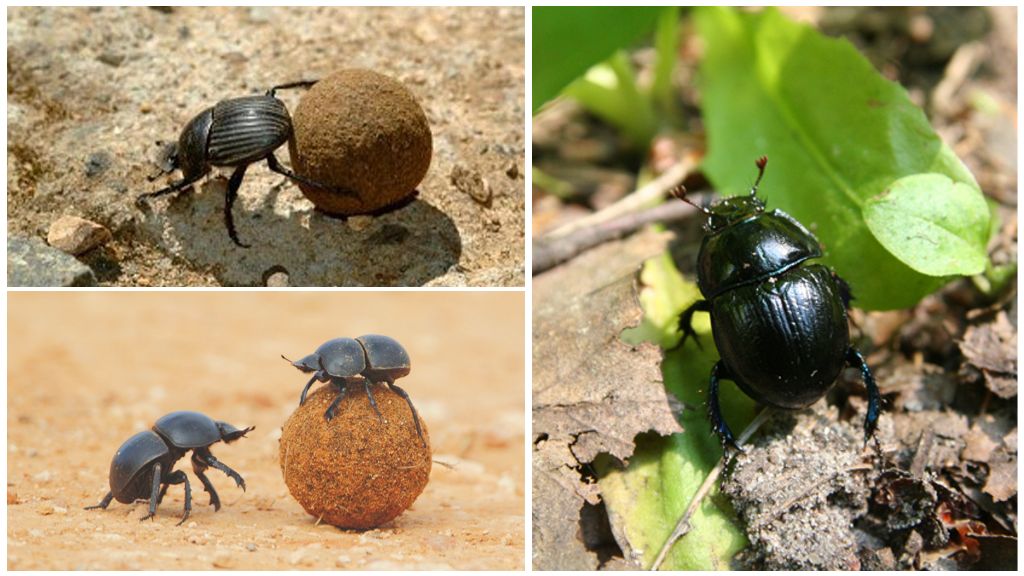
Balls of the correct form are rolled up from excrement. They roll to their place of residence, making incredible efforts. The weight of food is several times greater than his own. Dung bears know how to roll balls on the ground with their front and hind legs.
To prevent food from drying out, beetles bury it underground, when they get hungry, they get it. Often in the process of rolling balls hassles occur. The winner takes the prize. In hot weather, food protects dung beetles from overheating. The beetle climbs onto the ball, after a few minutes its body temperature drops by several degrees.
A large hard worker is active at night, hiding in a hole in a day or in a secluded place, away from the light. Often a refuge for him is a dunghill. The location of food is determined by smell, flies through the air or crawls on the ground. During the flight, a heavy hum is created, and the landing is always “stone”. It just falls to the ground.
In addition to feces, the beetle eats carrion, mushrooms. For this, he is called a pasture cleaner. Dung beetles drink water in a special way. In the morning or in the evening, wings are spread, dew drops are collected on them, which gradually roll into the mouth.
Interesting!
Rhinoceros beetles also belong to the dung beetle family, but they feed on decayed grass, sawdust, and crushed bark. Often settle in a compost pit.
Breeding
Beetle digging begins to breed in the summer. Lays eggs in a hole. At the very bottom is a special "room" where parents roll a ball. In each female lays an egg, thereby providing the larva with food for the entire cycle of its development. Male and female live together, close the entrance with a dung ball, wait until larvae appear. It takes from 20 to 28 days.
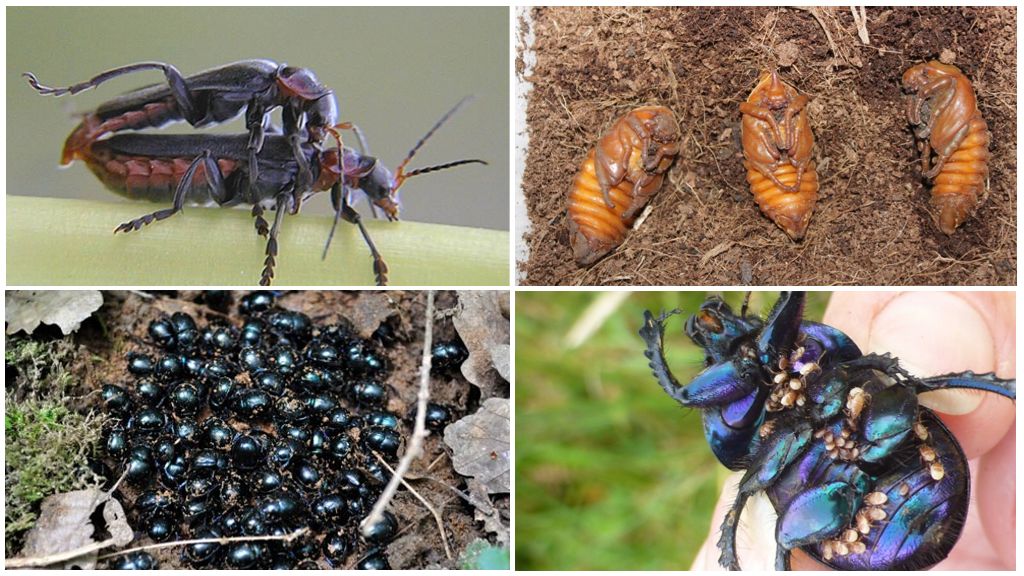
Interesting!
The larva of a dung beetle is born with a soft shell, white. As it grows, it molts several times, acquires a characteristic color. All this time, parents feed the cubs, do not eat anything themselves, and soon die. The young generation goes outside, spreads in different directions, builds its nests.
The beetle overwinter in the larval stage, being inside the dung ball. In the spring continues development.
Enemies of the dung beetle
The most common ticks of Gamasus coleoptratorum. Parasites live on the lower abdomen. White or reddish color, constantly swarming. They eat the beetle alive. Another enemy is vertebrate animals. Dogs, cats, foxes, wolves, hedgehogs, etc. are caught by small insects. Man is the main enemy. Thanks to technological progress, horses were replaced with tractors, combines, depriving beetles of food. The use of various insecticides in the fields, in the forests led to the mass death of excavators.
